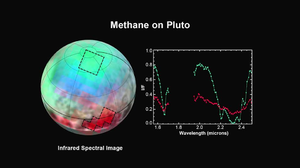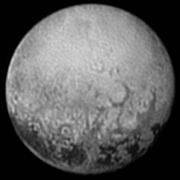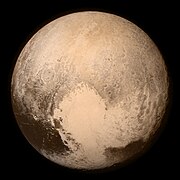Geology of Pluto: Difference between revisions
Kwamikagami (talk | contribs) |
Erielhonan (talk | contribs) →Surface features: specifying source of the fictional god Cthulhu, to distinguish it from all the other fictional gods |
||
| Line 15: | Line 15: | ||
The initial mapping of Pluto's surface by ''[[New Horizons]]'' has revealed several prominent surface features, which have been referred to by NASA and the press by descriptive names. |
The initial mapping of Pluto's surface by ''[[New Horizons]]'' has revealed several prominent surface features, which have been referred to by NASA and the press by descriptive names. |
||
* [[Heart (Pluto)|The "Heart"]], named ''Tombaugh Regio'' by the discovery team after the discoverer of Pluto, [[Clyde Tombaugh]], is a large, light-colored region in the [[Heart (symbol)|shape of a heart]]. Subsequent data indicated that each of the two lobes of the heart are distinct geological features sharing a bright appearance, with the western lobe smoother than the eastern lobe.<ref name="brokenheart">{{cite web|last1=Feltman|first1=Rachel|title=New data reveals that Pluto’s heart is broken|url=http://www.washingtonpost.com/news/speaking-of-science/wp/2015/07/14/new-data-reveals-that-plutos-heart-is-broken/|publisher=The Washington Post|accessdate=14 July 2015|date=14 July 2015}}</ref> The heart is about {{convert|990|mi|km|disp=flip|abbr=on}} across.<ref name="whale"/> Early speculation was that the western lobe may be a large impact crater filled with nitrogen snow.<ref name="arrives">{{cite web|last1=Achenbach|first1=Joel|title=New Horizons reaches Pluto, sees complex terrain with ‘great mounds’|url=http://www.washingtonpost.com/national/health-science/new-horizons-finally-makes-it-to-pluto-sees-craters-and-great-mounds/2015/07/14/9bcb0f04-2a1f-11e5-bd33-395c05608059_story.html|publisher=The Washington Post|accessdate=14 July 2015|date=14 July 2015}}</ref> |
* [[Heart (Pluto)|The "Heart"]], named ''Tombaugh Regio'' by the discovery team after the discoverer of Pluto, [[Clyde Tombaugh]], is a large, light-colored region in the [[Heart (symbol)|shape of a heart]]. Subsequent data indicated that each of the two lobes of the heart are distinct geological features sharing a bright appearance, with the western lobe smoother than the eastern lobe.<ref name="brokenheart">{{cite web|last1=Feltman|first1=Rachel|title=New data reveals that Pluto’s heart is broken|url=http://www.washingtonpost.com/news/speaking-of-science/wp/2015/07/14/new-data-reveals-that-plutos-heart-is-broken/|publisher=The Washington Post|accessdate=14 July 2015|date=14 July 2015}}</ref> The heart is about {{convert|990|mi|km|disp=flip|abbr=on}} across.<ref name="whale"/> Early speculation was that the western lobe may be a large impact crater filled with nitrogen snow.<ref name="arrives">{{cite web|last1=Achenbach|first1=Joel|title=New Horizons reaches Pluto, sees complex terrain with ‘great mounds’|url=http://www.washingtonpost.com/national/health-science/new-horizons-finally-makes-it-to-pluto-sees-craters-and-great-mounds/2015/07/14/9bcb0f04-2a1f-11e5-bd33-395c05608059_story.html|publisher=The Washington Post|accessdate=14 July 2015|date=14 July 2015}}</ref> |
||
* [[Whale (Pluto)|The "Whale"]], named ''Cthulhu'' by the discovery team after the [[ |
* [[Whale (Pluto)|The "Whale"]], named ''Cthulhu'' by the discovery team after the [[H._P._Lovecraft|Lovecraftian]] [[Cthulhu|deity]], is an elongated, dark region along Pluto's equator. It is {{convert|1860|mi|km|disp=flip|abbr=on}} long and is the largest dark feature on Pluto.<ref name="whale">{{cite web|last1=Feltman|first1=Rachel|title=New map of Pluto reveals a ‘whale’ and a ‘donut’|url=http://www.washingtonpost.com/news/speaking-of-science/wp/2015/07/08/new-map-of-pluto-reveals-a-whale-and-a-donut/|publisher=The Washington Post|accessdate=14 July 2015|date=8 July 2015}}</ref> |
||
* [[Donut (Pluto)|The "Donut"]] is a bright, ring-shaped feature about {{convert|350|km|mi|abbr=on}} across located near the tail of the "Whale" in low-resolution images.<ref>{{cite web|title=New Horizons Map of Pluto: The Whale and the Donut|url=https://www.nasa.gov/feature/new-horizons-map-of-pluto-the-whale-and-the-donut|publisher=NASA|accessdate=17 July 2015|archiveurl=https://web.archive.org/feature/new-horizons-map-of-pluto-the-whale-and-the-donut|archivedate=16 July 2015}}</ref> It does not appear in higher-resolution images. |
* [[Donut (Pluto)|The "Donut"]] is a bright, ring-shaped feature about {{convert|350|km|mi|abbr=on}} across located near the tail of the "Whale" in low-resolution images.<ref>{{cite web|title=New Horizons Map of Pluto: The Whale and the Donut|url=https://www.nasa.gov/feature/new-horizons-map-of-pluto-the-whale-and-the-donut|publisher=NASA|accessdate=17 July 2015|archiveurl=https://web.archive.org/feature/new-horizons-map-of-pluto-the-whale-and-the-donut|archivedate=16 July 2015}}</ref> It does not appear in higher-resolution images. |
||
[[File:PlutoMapFeatures.jpg|thumb|Cthulhu and the "Knuckles". Part of Meng-p'o appears at the far right.]] |
[[File:PlutoMapFeatures.jpg|thumb|Cthulhu and the "Knuckles". Part of Meng-p'o appears at the far right.]] |
||
Revision as of 04:11, 18 July 2015
This article may be affected by the following current event: New Horizons. Information in this article may change rapidly as the event progresses. Initial news reports may be unreliable. The last updates to this article may not reflect the most current information. (July 2015) |

The geology of Pluto consists of the characteristics of the surface, crust, and interior of Pluto. Because of Pluto's distance from Earth, in-depth study from Earth is difficult. Because of this, many details about Pluto remained unknown until 14 July 2015 and onwards, when New Horizons flew through the Pluto system.[1]
Surface

Pluto's surface is composed of more than 98 percent nitrogen ice, with traces of methane and carbon monoxide.[2] The face of Pluto oriented toward Charon contains more methane ice, whereas the opposite face contains more nitrogen and carbon monoxide ice.[3]
Maps produced from images taken by the Hubble Space Telescope (HST), together with Pluto's lightcurve and the periodic variations in its infrared spectra, indicate that Pluto's surface is very varied, with large differences in both brightness and color,[4] with albedos between 0.49 and 0.66.[5] Pluto is one of the most contrastive bodies in the Solar System, with as much contrast as Saturn's moon Iapetus.[6] The color varies between charcoal black, dark orange and white.[7] Pluto's color is more similar to that of Io with slightly more orange, significantly less red than Mars.[8]
Pluto's surface color has changed between 1994 and 2003: the northern polar region has brightened and the southern hemisphere has darkened.[7] Pluto's overall redness has also increased substantially between 2000 and 2002.[7] These rapid changes are probably related to seasonal condensation and sublimation of portions of Pluto's atmosphere, amplified by Pluto's extreme axial tilt and high orbital eccentricity.[7]
Surface features

(12 July 2015).
The initial mapping of Pluto's surface by New Horizons has revealed several prominent surface features, which have been referred to by NASA and the press by descriptive names.
- The "Heart", named Tombaugh Regio by the discovery team after the discoverer of Pluto, Clyde Tombaugh, is a large, light-colored region in the shape of a heart. Subsequent data indicated that each of the two lobes of the heart are distinct geological features sharing a bright appearance, with the western lobe smoother than the eastern lobe.[9] The heart is about 1,590 km (990 mi) across.[10] Early speculation was that the western lobe may be a large impact crater filled with nitrogen snow.[11]
- The "Whale", named Cthulhu by the discovery team after the Lovecraftian deity, is an elongated, dark region along Pluto's equator. It is 2,990 km (1,860 mi) long and is the largest dark feature on Pluto.[10]
- The "Donut" is a bright, ring-shaped feature about 350 km (220 mi) across located near the tail of the "Whale" in low-resolution images.[12] It does not appear in higher-resolution images.

- The "Brass Knuckles" are a series of semi-regularly spaced dark spots with irregular boundaries, each about 480 km (300 mi) in diameter. They are located between the Heart and the Whale's tail.[13][14] Proposed names for the knuckles are:[15][16]
- Krun, after a Mandaean lord of the underworld. South of the right lobe of Tombaugh Regio.
- Ala, after an underworld and harvest deity of the Igbo people. East of Krun.
- Balrog, after a race of demons in The Lord of the Rings. The largest of the Knuckles.
- Vucub-Came and
- Hun-Came, after the two leading Maya death gods in the Popol Vuh.
- Meng-p'o, after a Chinese mythological figure who ensured that the dead would forget their past lives. East of Hun-Came and just west of the whale's tail.
The International Astronomical Union has decided that Pluto's surface features will ultimately be given permanent names deriving from the following themes: explorers, space missions, spacecraft, scientists and engineers; fictional explorers, travellers, vessels, destinations and origins; authors and artists who have envisioned exploration; and fictional underworlds, underworld beings, and travellers to the underworld. In collaboration with the New Horizons science team, the IAU has invited members of the public to propose names and vote on them before the spacecraft's arrival.[17]
Internal structure

- 1. Frozen nitrogen[2]
- 2. Water ice
- 3. Rock
Pluto's density is 2.03±0.06 g/cm3.[19] Because the decay of radioactive elements would eventually heat the ices enough for the rock to separate from them, scientists expect that Pluto's internal structure is differentiated, with the rocky material having settled into a dense core surrounded by a mantle of water ice.[20]
The diameter of the core is hypothesized to be approximately 1700 km, 70% of Pluto's diameter.[18] It is possible that such heating continues today, creating a subsurface ocean layer of liquid water some 100 to 180 km thick at the core–mantle boundary.[18][20][21] The DLR Institute of Planetary Research calculated that Pluto's density-to-radius ratio lies in a transition zone, along with Neptune's moon Triton, between icy satellites like the mid-sized moons of Uranus and Saturn, and rocky satellites such as Jupiter's Io.[22]
See also
Gallery
-
Hubble map of Pluto's surface (2005)
-
Hubble views of Pluto (2010)
-
Hubble maps of Pluto's surface (2010)
-
New Horizons map of Pluto's surface (2015)

(6 July 2015).
-
Pluto - near equator - as viewed by New Horizons (14 July 2015).[23]
References
- ^ Brown, Dwayne; Buckley, Michael; Stothoff, Maria (15 January 2015). "January 15, 2015 Release 15-011 - NASA's New Horizons Spacecraft Begins First Stages of Pluto Encounter". NASA. Retrieved 15 January 2015.
- ^ a b Owen, Tobias C.; Roush, Ted L.; Cruikshank, Dale P.; et al. (1993). "Surface Ices and the Atmospheric Composition of Pluto". Science. 261 (5122): 745–748. Bibcode:1993Sci...261..745O. doi:10.1126/science.261.5122.745. PMID 17757212.
- ^ Boyle, Alan (11 February 1999). "Pluto regains its place on the fringe". MSNBC. Retrieved 20 March 2007.
- ^ Buie, Marc W.; Grundy, William M.; Young, Eliot F.; et al. (2010). "Pluto and Charon with the Hubble Space Telescope: I. Monitoring global change and improved surface properties from light curves". Astronomical Journal. 139 (3): 1117–1127. Bibcode:2010AJ....139.1117B. doi:10.1088/0004-6256/139/3/1117.
- ^ Hamilton, Calvin J. (12 February 2006). "Dwarf Planet Pluto". Views of the Solar System. Retrieved 10 January 2007.
- ^ Buie, Marc W. "Pluto map information". Retrieved 10 February 2010.
- ^ a b c d Villard, Ray; Buie, Marc W. (4 February 2010). "New Hubble Maps of Pluto Show Surface Changes". News Release Number: STScI-2010-06. Retrieved 10 February 2010.
- ^ Buie, Marc W.; Grundy, William M.; Young, Eliot F.; et al. (2010). "Pluto and Charon with the Hubble Space Telescope: II. Resolving changes on Pluto's surface and a map for Charon". Astronomical Journal. 139 (3): 1128–1143. Bibcode:2010AJ....139.1128B. doi:10.1088/0004-6256/139/3/1128.
- ^ Feltman, Rachel (14 July 2015). "New data reveals that Pluto's heart is broken". The Washington Post. Retrieved 14 July 2015.
- ^ a b Feltman, Rachel (8 July 2015). "New map of Pluto reveals a 'whale' and a 'donut'". The Washington Post. Retrieved 14 July 2015.
- ^ Achenbach, Joel (14 July 2015). "New Horizons reaches Pluto, sees complex terrain with 'great mounds'". The Washington Post. Retrieved 14 July 2015.
- ^ "New Horizons Map of Pluto: The Whale and the Donut". NASA. Retrieved 17 July 2015.
{{cite web}}:|archive-url=is malformed: timestamp (help) - ^ Chang, Kenneth (12 July 2015). "The Dark Belt Around Pluto". The New York Times. Retrieved 14 July 2015.
- ^ Feltman, Rachel (2 July 2015). "Pluto shows mysterious spots in new NASA photos". The Washington Post. Retrieved 14 July 2015.
- ^ Chang, Kenneth (14 July 2015). "NASA's New Horizons Spacecraft Completes Flyby of Pluto". The New York Times. Retrieved 14 July 2015.
- ^ Rogers, Adam (14 July 2015). "The New, Nerdy Mythology of Pluto's Place Names". Wired. Retrieved 14 July 2015.
- ^ "Nominate a Name!". Our Pluto. Retrieved 21 March 2015.
- ^ a b c
Attention: This template ({{cite doi}}) is deprecated. To cite the publication identified by doi:10.1016/j.icarus.2006.06.005 , please use {{cite journal}} (if it was published in a bona fide academic journal, otherwise {{cite report}} with
|doi=10.1016/j.icarus.2006.06.005instead. - ^ Buie, Marc W.; Grundy, William M.; Young, Eliot F.; et al. (2006). "Orbits and photometry of Pluto's satellites: Charon, S/2005 P1, and S/2005 P2". Astronomical Journal. 132 (1): 290. arXiv:astro-ph/0512491. Bibcode:2006AJ....132..290B. doi:10.1086/504422.
- ^ a b "The Inside Story". pluto.jhuapl.edu – NASA New Horizons mission site. Johns Hopkins University Applied Physics Laboratory. 2007. Retrieved 11 July 2015.
- ^ "What is Pluto made of?". Space.com. 20 November 2012. Retrieved 11 July 2015.
- ^ DLR Interior Structure of Planetary Bodies DLR Radius to Density The natural satellites of the giant outer planets...
- ^ Chang, Kenneth (15 July 2015). "Pluto as New Horizons Saw It: Up Close and Personal". New York Times. Retrieved 15 July 2015.













![Pluto - near equator - as viewed by New Horizons (14 July 2015).[23]](http://upload.wikimedia.org/wikipedia/commons/thumb/0/01/15-152-Pluto-NewHorizons-HighResolution-20150714-IFV.jpg/272px-15-152-Pluto-NewHorizons-HighResolution-20150714-IFV.jpg)

